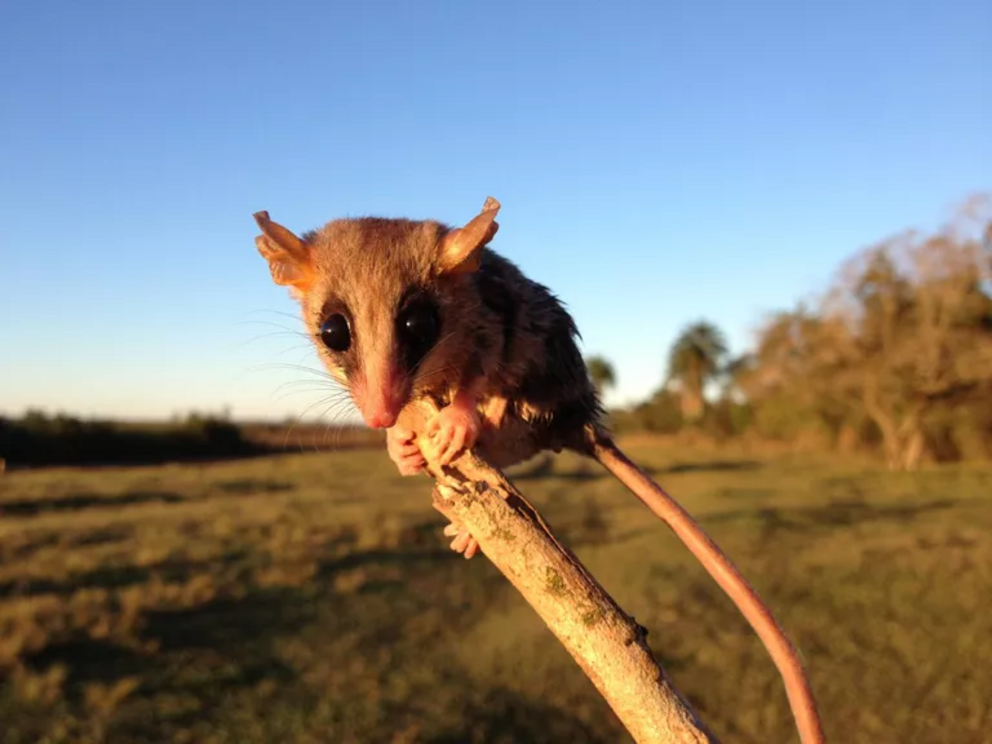Habitat loss and deforestation are stressing out animals
A mouse opossum from a deforested area of the Atlantic Forest, eastern Paraguay.
Higher levels of stress hormones were found in animals in smaller forest areas.
People aren’t the only ones stressed about the destructive changes happening in nature. Science shows that deforestation is affecting the well-being of non-human animals too.
In a new study, researchers discovered higher levels of stress hormones in rodents and marsupials living in deforested parts of the Atlantic Forest in South America compared to those living in more intact forests. The findings were published in the journal Scientific Reports.1
Studies from across the globe have found that when species undergo habitat loss and fragmentation, some species may go extinct locally, lead author Sarah Boyle, an associate professor of biology and chair of the Environmental Studies and Sciences Program at Rhodes College in Memphis, Tennessee, tells Treehugger.
“However, for those animals that may live in a habitat that has been heavily degraded or diminished from the typical habitat of that species, there may be changes in the animal’s diet, amount of space it uses, increased competition for food, and greater risk of disease transmission,” Boyle says.
“Not all species respond in the same way to environmental pressures, and not all habitats have been impacted to the same degree as all other habitats, so we wanted to study this topic with small mammals.”
Understanding Stress
When an animal’s habitat is destroyed or even changed, it can have a drastic impact on its life.1 Because habitat loss means less territory and less food, there’s greater competition with other animals for all sorts of critical resources. That can amount to long-term stress.
Not all stress is bad; short-term stress is critical to survival.
“Acute stress responses can help an animal survive a stressful situation, such as escaping a predator,” says co-author David Kabelik, an associate professor of biology and chair of the neuroscience program at Rhodes College. “Chronic stress, however, can lead to physiological, neural, and immune dysfunction. For example, chronic stress can lead to cardiovascular and digestive disease, stunt growth, and impair reproduction.”
Researchers focused on studying the impact of chronic stress in hard-hit areas like the Atlantic Forest (AF) in South America. The second most diverse forest system after the Amazon, it extends from northeastern Brazil to eastern Paraguay, but has been reduced to about one-third of its original size because of deforestation, coauthor Noé de la Sancha, a research associate at the Field Museum in Chicago and associate professor of biology at Chicago State University, tells Treehugger.
“The AF of Paraguay is the least known portion of the AF and much of this habitat was virtually intact as early as the 1940s,” de la Sancha says. “Members of our team have been working in the Paraguayan AF since 2005 trying to understand the impacts of deforestation on biodiversity, and small mammals are perfect models for these types of ecological questions.”
Increased Potential for Disease
For the study, researchers focused on parts of forest in eastern Paraguay, which was especially affected over the last century due to clearing for firewood, farming, and agriculture. They trapped 106 mammals, including five species of rodents and two marsupial species, and took samples of the animals’ fur.
Hormones collect in hair over days or weeks, so they can offer a better snapshot of typical levels of stress than a blood sample.
"Hormones change in the blood minute by minute, so that's not really an accurate reflection of whether these animals are under long-term stress or whether they just happened to run away from a predator a minute ago," says Kabelik, "and we were trying to get at something that's more of an indicator of longer term stress. Since glucocorticoid stress hormones get deposited into the fur over time, if you analyze these samples you can look at a longer term measure of their stress."
So the researchers measured levels of the hormones corticosterone and cortisol. They extracted the hormones from the fur clippings by grinding the fur into a fine powder. Then they analyzed hormone levels using a test called an enzyme immunoassay.
The findings showed that animals from smaller patches of forest had higher levels of stress hormones than animals from larger patches of forest.
"In particular, these findings are highly relevant for countries like Paraguay that currently show an accelerated rate of change in natural landscapes. In Paraguay, we are just beginning to document how the diversity of species that are being lost is distributed," says co-author Pastor Pérez, a biologist at Universidad Nacional de Asunción. "However, this paper shows that we also have a lot to learn about how these species interact in these environments."
The findings could reveal more information on how stressed-out animals could spread disease to humans, the researchers suggest. Although it wasn't tested in this study, there is evidence to suggest that animals that are more stressed may be more susceptible to disease, de la Sancha tells Treehugger.
"As humans are changing more landscapes around the globe (for example through deforestation), we are increasing the potential for emerging and zoonotic diseases," he says.

